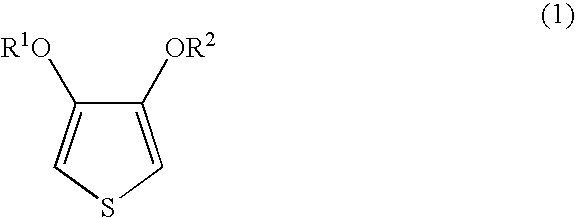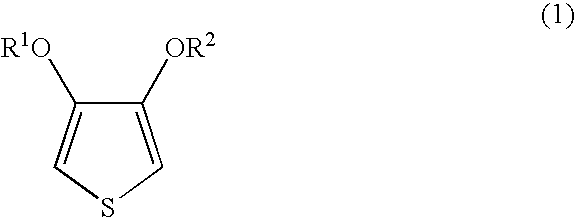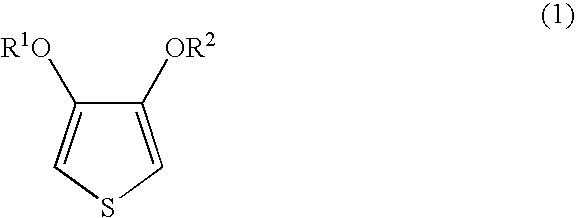Process For Producing Aqueous Dispersion Of Composite Of Poly(3,4-Dialkoxythiophene) With Polyanion
- Summary
- Abstract
- Description
- Claims
- Application Information
AI Technical Summary
Benefits of technology
Problems solved by technology
Method used
Image
Examples
example 1.1
[0053]Nippon NSC (Co.) polystyrenesulphonic acid 9×401 was subjected to ultrafiltration using Biomax-100 manufactured by the Millipore Co., after which cation-exchange was carried out and, by dilution with desalted water, 1,887 parts of an aqueous solution containing 24.7 parts of polystyrenesulphonic acid (weight average molecular weight 253,000; percentage sulphonation 90%) obtained. 49 parts of a 1% aqueous iron(III) sulphate solution, 30 parts of concentrated nitric acid and 8.8 parts of 3,4-ethylenedioxythiophene were added to this aqueous solution and stirring performed and then, while maintaining the temperature within the reaction system at 10° C., 121 parts of 10.9% aqueous peroxodisulphuric acid solution (obtained by mixing a 15% aqueous sodium peroxodisulphate solution with 1.2 times the mass of S100H, and then filtering) was added dropwise over 6 hours. The sodium ion concentration in the reaction liquid after the addition of the aqueous peroxodisulphuric acid solution w...
example 1.2
[0054]Nippon NSC (Co.) polystyrenesulphonic acid 9×401 was subjected to ultrafiltration using Biomax-100 manufactured by the Millipore Co., after which cation-exchange was carried out and, by dilution with desalted water, 1,887 parts of an aqueous solution containing 24.7 parts of polystyrenesulphonic acid (weight average molecular weight 253,000; percentage sulphonation 90%) obtained. 49 parts of a 1% aqueous iron(III) sulphate solution, 30 parts of concentrated nitric acid and 8.8 parts of 3,4-ethylenedioxythiophene were added to this aqueous solution and stirring performed and then, while maintaining the temperature within the reaction system at 10° C., 121 parts of 10.9% aqueous peroxodisulphuric acid solution (obtained by passing 15% aqueous sodium peroxodisulphate solution through a column packed with 4.0 times the mass of S100H) was added dropwise over 18 hours. The sodium ion concentration in the reaction liquid after the addition of the aqueous peroxodisulphuric acid soluti...
example 1.3
[0055]Nippon NSC (Co.) Versa-TL125 was subjected to ultrafiltration using Biomax-100 manufactured by the Millipore Co., after which cation-exchange was carried out and, by dilution with desalted water, 1,887 parts of an aqueous solution containing 24.7 parts of polystyrenesulphonic acid (weight average molecular weight 125,000; percentage sulphonation 100%) obtained. 49 parts of a 1% aqueous iron(III) sulphate solution, 30 parts of concentrated nitric acid and 8.8 parts of 3,4-ethylenedioxythiophene were added to this aqueous solution and stirring performed, and then 121 parts of 10.9% aqueous peroxodisulphuric acid solution (obtained by passing 15% aqueous sodium peroxodisulphate solution through a column packed with 2.0 times the mass of S100H) was added all in one go and stirring carried out. The sodium ion concentration in the reaction liquid after the addition of the aqueous peroxodisulphuric acid solution was 13 ppm and no other alkali metal ions were detected. Stirring was ca...
PUM
| Property | Measurement | Unit |
|---|---|---|
| Fraction | aaaaa | aaaaa |
| Fraction | aaaaa | aaaaa |
| Fraction | aaaaa | aaaaa |
Abstract
Description
Claims
Application Information
 Login to View More
Login to View More - R&D
- Intellectual Property
- Life Sciences
- Materials
- Tech Scout
- Unparalleled Data Quality
- Higher Quality Content
- 60% Fewer Hallucinations
Browse by: Latest US Patents, China's latest patents, Technical Efficacy Thesaurus, Application Domain, Technology Topic, Popular Technical Reports.
© 2025 PatSnap. All rights reserved.Legal|Privacy policy|Modern Slavery Act Transparency Statement|Sitemap|About US| Contact US: help@patsnap.com



